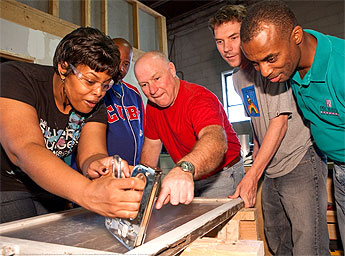Up In Smoke: How LIHEAP Could (But Doesn’t) Reduce State Deficits And Carbon Footprint
WBEZ reported this morning that Illinois Governor Bruce Rauner’s deficit crusade will slash utility bill subsidies for lower-income customers through Illinois’ contribution to LIHEAP, or Low-Income Home Energy Assistance Program. Rauner’s argument in favor of cutting the $165 million in funding matching the annual federal LIHEAP grant will certainly have a major impact on the state’s troubled budget, but will more certainly have major ramifications for the poor during our current climate of stagnant wages and economic uncertainty. However, while it’s clear that Illinois can’t continue to run such staggering deficits, LIHEAP is a perfect example of a program that has become an economic default rather than a real solution to an increasingly important energy problem, and the budget cuts– some of which are inevitable at this point owing to a deadlock in the legislature- may indeed provide an opportunity to address this through a deeper conversation.
LIHEAP, a program operated by the US Department of Health and Human Services, was borne out of the energy crisis in the 1970’s. Congress wanted to create a system for value capture to ensure that major upward fluctuations in energy prices wouldn’t result in disproportionately adverse effects for the poor and so created LIHEAP from taxes on oil (meanwhile, that same energy crisis helped create movements to build super-efficient homes like Passive House). Within a few years the program added support not only for heating but also for the much more energy-intensive process of cooling a home (even though more than half of LIHEAP money goes to heating while only pennies on the dollar go to cooling). Subsidies are calculated by economic, demographic, and climate data– but kind of not, because, as shown in the table below, LIHEAP favors states with fewer heating degree days.
| Region | State | Heating Degree Days (HDD) in 2014* | Per Household Subsidy | Average Subsidy (Cents Per HDD) |
| Midwest | Illinois | 6760 | 501.21 | 7.41 |
| Ohio | 6438 | 367.34 | 5.71 | |
| Missouri | 5969 | 505.5 | 8.47 | |
| Michigan | 8364 | 265.42 | 3.17 | |
| Minnesota | 9415 | 733.81 | 7.79 | |
| Wisconsin | 8715 | 458.77 | 5.26 | |
| South | Florida | 2058 | 1033.34 | 50.21 |
| North Carolina | 4159 | 993.66 | 23.89 | |
| Louisiana | 2357 | 1522.38 | 64.59 |
(Balance point of 68°F HDD calculated from data collected in individual states’ capital cities.)
Funding started in 1981 at about a billion dollars and didn’t really increase appreciably until the late 2000’s, by which time the US population had increased by about 50% from its 1980 numbers, and LIHEAP, previously stagnant and not indexed to population growth, eventually caught up, ballooning to a now-typical annual range of $3-4 billion. Of that, only about 10% was used for weatherization through the REACH program and others (see Perl, 2013), a number that did not vary over time or geography, per 2012 case studies of Colorado and Florida. LIHEAP began using what they called “contingency” financing to request additional appropriations for “emergency” conditions in weather– extreme cold or heat- but this ended up being used so frequently to be meaningless, and states began to adopt their own policies to supplement the program like Illinois did. This may explain the discrepancies in funding between states.

What is not immediately clear to someone less learned in the machinations of federal bureaucracy is why LIHEAP has such substantially better funding than, say, comparable Department of Energy programs. If the state is following the 2008 numbers (referenced in the previous paragraph) in 2015, that means that its 2015 request for a DoE weatherization grant is about equal to the amount the state kicks in for weatherization from its LIHEAP funding, even at that mere 10%. Steve Savage with Illinois’ Department of Commerce and Economic Opportunity (DCEO) could not be immediately reached for comment.

As the program is administered through HHS, it is separate from Department of Energy initiatives like EnergyStar and is also separate from pools of money from Housing and Urban Development that support utility bills for Section 8 and other subsidized renters. While the alphabet soup of federal agencies increasingly involved in addressing energy issues is an important sign of the times, the facts are clear, especially based on the roughly 10%-on-weatherization figures: We are not moving toward a net zero energy model through programs like LIHEAP, and that is going to have to change unless we are okay with budget deficits.
Up In Smoke? An Economic Case and Policy Blueprint for Net Zero
Groundbreaking revelation: The first law of thermodynamics (remember? energy can’t be created or destroyed, only transferred) does not apply to money. When you pay your utility bill, that money is literally going up in smoke—coal is extracted from the ground and burned. While the poor rely on subsidies to cover part of that cost (LIHEAP may amount to a few hundred dollars a year, so it’s not paying the entirety of your bills), the government continues to send this money up in smoke– where it could be investing in energy retrofits. Since we can’t get that money back, we might as well figure out ways to reduce our footprint.

At a building-by-building level, this is done through an energy retrofit. It’s also done by aggressively stepping up building code requirements, as states like California and Illinois are doing as we move toward requiring net-zero energy construction by 2020 (though I’m holding out for 2030). Reducing energy load:
1) reduces strain on public utilities (NB: extremely expensive and rapidly aging infrastructure),
2) reduces carbon footprint, and,
3) in reducing the burden on the poor of utility bills,
4) would further reduce government expenditure to subsidize these costs.
We’re not talking pennies, we’re talking the entirety of the LIHEAP budget, which some policymakers are continually pushing to increase– past the four or five billion dollar mark. The unrealistic but ultimately true reality is that, had that funding provided by LIHEAP and REACH instead been used to provide long-term financing for energy retrofits to convert housing stock to net zero energy, the program would, eventually, no longer have to provide utility bill subsidies at all. Even a fifteen-year payback on improvements would mean that money invested in 2000 would result in net zero housing stock by 2015. Of course, this is lofty considering we wouldn’t be talking about $3-4 billion in annual federal subsidy but rather many more billions– but in a one-time expenditure. (LIHEAP has cost the public $40 billion since 2003 and that’s without individual state subsidies).
Plenty of programs are already in place: PACE is already a hit in Illinois with nearly half a billion dollars of projects in the pipeline or already completed, and Michigan is languidly moving forward, too. Indiana Governor Mike Pence doesn’t seem to be able to so much as spell “energy efficiency,” and it’s not surprising that PACE hasn’t gotten off the ground there, but that’ll come, too.
Utility bills may represent an energy crisis for a low-income homeowner or renter as well as a burden on state finance, especially in the cash-strapped municipalities of the Rust Belt that are torn between continuing to run inefficient, large governments and completely doing away with programs that work at least better than the alternative of, well, letting them eat cake, as it were. But in the net zero future, programs like LIHEAP don’t exist at all– so it’s important to use instances like Bruce Rauner’s deficit crusade to ask important questions about how we can ensure that federal and state programs work together to solve a problem by creating an energy efficient built environment, not just continue to send cash up the flue pipe.

